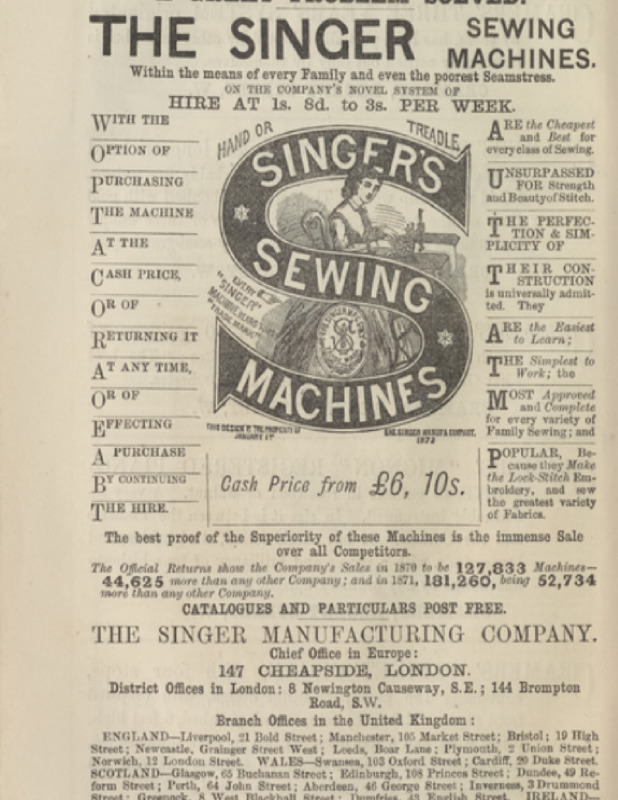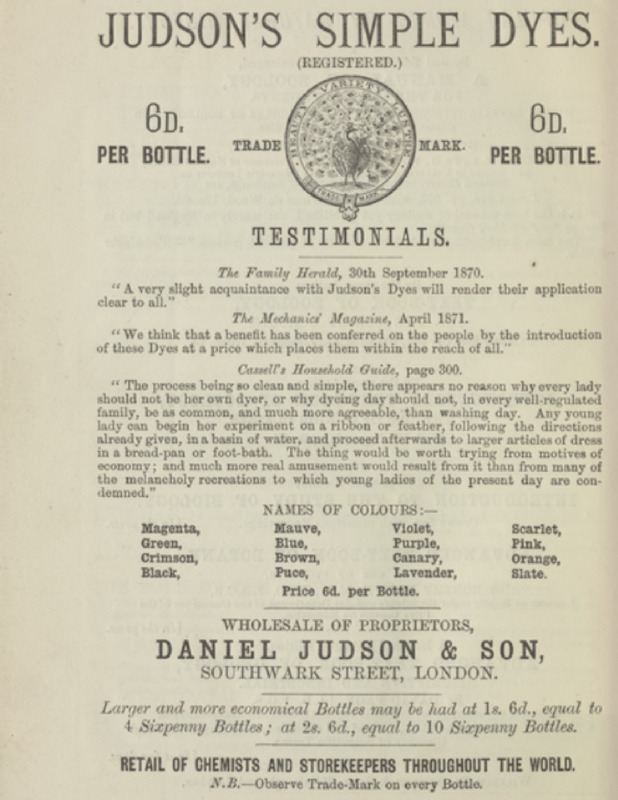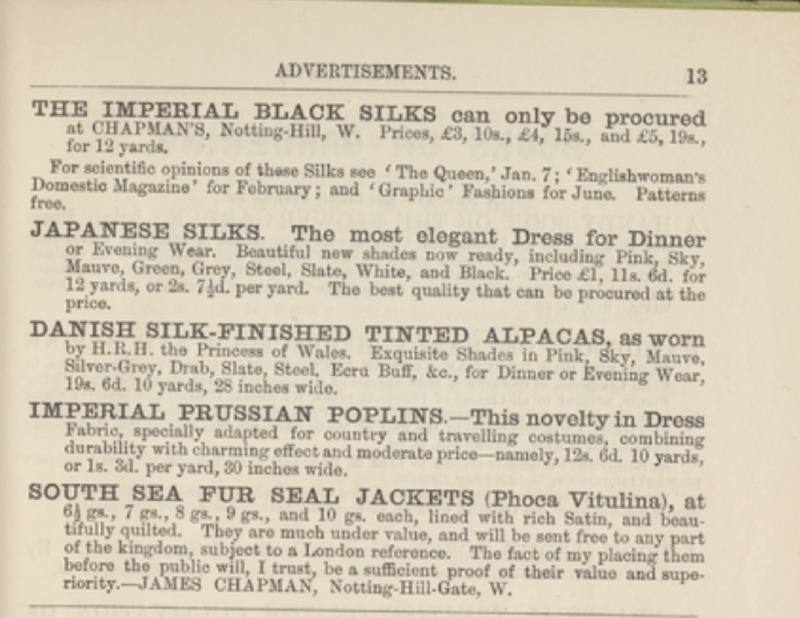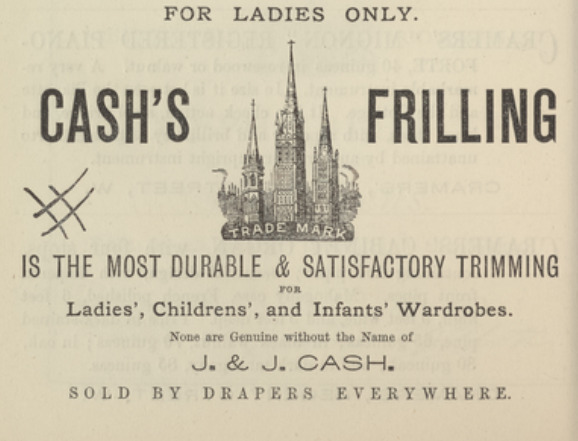Reading the Rotting Silk: Dress Culture, Sewing, and Materiality in George Eliot's Middlemarch
Upon reading through George Eliot’s Middlemarch in the original publishing context, readers would have seen a barrage of advertisements for textiles, sewing machines, and other dress-related goods. Female readers would be intimately familiar with dress culture and sewing would be a part of their daily life, for women of all classes. In looking at the text itself, Eliot also employs use of the cultural milieu as it relates to dress culture, and took advantage of women’s cultural and social knowledge in the crafting of the story. Not only were Eliot’s readers literate, they were literate in the language of textiles. Eliot speaks this language by associating her female characters with their dress and with sewing, creating a relationship between the animate person and the inanimate objects which they wear and create. Female reader’s dual literacy in text/textiles would be an illuminating factor of their interpretation and formulation of meaning, context, and implications of Middlemarch. Eliot’s employment of dual literacy transcends the metaphorical and moves into a literal equation of clothing and textiles as animated and voiced.
Eliot communicates characterization and tone to her readers through the use of historically-specific conventions, behaviours, and social norms that may not be immediately clear to modern readers removed from Middlemarch’s original context. The ritual of sewing, specifically, clusters around Mary Garth and demonstrates to Eliot’s female readership Mary’s status as a classical heroine harkening back to and developing associations with an older and specifically rural space and place. Her functional and utilitarian relationship with sewing marks her as middle-class and self-sufficient and indicates her literacy in the language of textiles. She also uses sewing to create private, domestic communication between women as a way to quietly assert agency and opinion. Female readers of Middlemarch would not only likely be able to sew, but would understand sewing as something socially expected of women as a part of regular education. Frequency of and type of sewing would denote class and enrich the characterization of woman characters in the novel. This advertisement of a sewing machine is just one of many which appear in the original prints of Middlemarch, emphasising the sheer scale of sewing culture and how almost every woman would have to have some knowledge and ability to sew, whether for survival or to boost social credit. The language used in these sewing machine advertisements give readers context as to how ingrained sewing was in women’s social culture at the time as well as drawing attention to the way female characters move through the novel itself.
The Singer’s Sewing machine advertisement is marketed as cheap, attempting to catch the attention of working-class women. Sewing machines are utilitarian in nature, and the marketing technique highlights class discrepancy between “fancy work” and “plain work.” Chrstine Bayles Kortsch notes in Dress Culture in Late Victorian Women’s Fiction: Literacy, Textiles and Activism that “wealthy women, by contrast, relied on seamstresses and domestic servants to do their plain sewing, putting their fingers only to fancy work[.]” (31) In “Three Love Problems” Mary is asked by Rosamund to sew a handkerchief for her upcoming wedding, because Mary’s sewing is “exquisite.” Rosamund, in contrast to Mary, is never depicted sewing and instead exports the labour to Mary and other domestic servants. From a Victorian context, where almost all girls were taught and expected to sew, her use of domestic servants further characterises Rosamund as vapid. Despite her status as middle-class, she exports her labour to a domestic servant as a wealthy woman would. By contrast, Mary is frequently seen sewing, and is thus offered interiority and substance. Mary ‘s sewing is evocative of the romanticisation of hard work and the “self made man”, and her sewing is depicted in scenes of charming domestic bliss, ones which both demonstrate Mary’s humility and strength of character: ‘“she was now in her usual place by the fire, with sewing in her hands and a book open on the little table by her side” (Eliot 133).
Mary is both a reader and skilled in sewing, both of which were markers of an educated Victorian girl. Kortsch writes that “women were expected to exercise a dual literacy in the language of print and the language of cloth, and woman novelists used that dual literacy for a variety of purposes” (24). Not only does Mary wield this dual literacy adeptly herself, Eliot melds together both kinds of literacy in order to weave a narrative about Mary. Her sewing is an extension of her, a material she comes into contact with which both shapes her character and acts as an outlet for thought and emotion – at one point, she says that “I must get this sewing done. It is for Rosamund Vincy: she is to be married next week, and she can’t be married without this handkerchief” (Eliot 331). The handkerchief she weaves is the mouthpiece for Mary’s lighthearted dig at Rosamund’s character. This glib, sarcastic remark is bolstered by her faux-concern about Rosamund’s wedding handkerchief being done on time. Not only is the existence of this item generating a multitude of associations and feelings within Mary herself, but the weaving of the material mirrors the weaving together of these literary characters – needle through thread, Mary through Rosamund.
Women were also expected to have a sophisticated knowledge of dress and fashion, of the trends and the social taboos surrounding different kinds of dress. Moral superficiality was communicated through inappropriately garish dressing, drawing in associations of harlotry, vapidity and deviance. An advertisement for dye in the original prints of Middlemarch suggests that brightly-coloured clothing could be easily and widely available for upper middle class women, and were marketed not as an expensive luxury but instead as a household necessity. For “the poorest of seamstresses,” the advertisement is for Judson’s Simple Dyes (emphasis added by me), the brand itself distanced from notions of luxury and instead touting a middle-class simple sensibility. Female readers of Middlemarch would understand that brightly coloured cloth was merely an attempt to position oneself as wealthy.
The people of Middlemarch are a people hungry for gossip, enjoying weaving together elaborate stories related to the clothing and cloth the subject of their scrutiny touches, and contact with the “wrong” kind of goods alters reputations irreparably. When an ugly dress or unnecessarily brightly-dyed fabric indicates moral repugnancy, these textiles are offered immense power– Mr. Vincy mentions how “Plymdale’s house uses those blue and green dyes it gets from the Brassing manufactory; they rot the silk, that’s all I know about it. Perhaps if other people knew so much of the profit went to the glory of God, they might like it better” (Eliot 128). This association of ostentatiously bright dyes and bad, rotting silk cannot shake itself from the perceived character of Ned Plymdale, and ugliness clings to him: “To superficial observers his chin had too vanishing an aspect, looking as if it were being gradually reabsorbed” (Eliot 236). Plymdale’s appearance is not only unattractive but he is seemingly shrinking (or rotting) back into himself, disappearing, reabsorbing his features.
There is an overarching opinion amongst Middlemarchers that bright dyes are signs of both literal and moral rot, which is a belief that is spread most effectively through gossip: “when a woman past forty has pink strings always flying, and that light way of laughing at everything, it’s very unbecoming” (Eliot 111). Mrs Vincy’s brightly-coloured cap strings are seen as indicative of vacuity, and whether or not there is direct correlation between the two, this gossip risks compromising her reputation. Kortsch writes that “gossip is like a garment, made up of things said and not said, seen and unseen, yet when organised into a cohesive whole, somehow undeniable” (46). I argue that gossip not only operates materially as a garment, but that both clothing and gossip contain socially and physically transformative properties. In Middlemarch the fabric of a garment and fabric of gossip cling in similar ways and operate with a similar materiality, and the further context provided by the original prints illuminates the broader cultural implications of Victorian clothing culture.
Antithetical to Vincy's ostentatious way of dressing, Dorothea is exclusively described as plain, dressed in brown, white, and black woollen garments. An advertisement for textiles in the original prints indicates that fabric quality and type was knowledge commonly proliferated among Victorians. The advertisements use luxurious, expensive language, targeted more towards upper-class women. The advertisement promises a worldliness Dorothea chooses to instead gain from her education and philanthropic pursuits, seemingly rejecting the luxury and status offered by embracing her class position. She is in fact, entirely ignorant of how things cost, in stark contrast to the more self-conscious Rosamund and even Lydgate. Dorothea is representative of “quiet” luxury, antithetical to the silk advertisement which openly flaunts notions of luxury. Dorothea belongs to this upper class, and yet she is never depicted wearing silk, fur, or animal skins that the advertisement pushes. Dorothea’s choice to wear wool, a widely available and cheaper fabric, would indicate to readers that she does not enjoy luxuries and instead chooses a life of humility and philanthropy, while also setting her apart from what the stereotypical rich woman.
However, Dorothea’s intense desire to escape her own wealth contradictorily turns into a luxury in itself, a way for her savour herself, and Eliot demonstrates this by drawing attention to Dorothea’s attire through decadent descriptions – “looking in her plain dress of some thin woollen-white material, without a single ornament on her besides her wedding-ring, as if she were under a vow to be different from all other women” (Eliot 304). Eliot’s use of clothing to shape character is not metaphorical, but is instead grounded in reality. Her characters put up a facade through their appearance which completely determines their perception, and thus that perception is what becomes reality. The line between internal and external is blurred, the way that gossip and rumour becomes fact. Their clothing clings to them and becomes a second skin, entirely epidermal. Dorothea’s plain clothes are inextricable from her own body, a defining feature as much as her face and body are, and yet they are entirely reliant on the fact that they are not necessary. She is “under a vow to be different from all other women”, the piety in her plainness reliant on the fact that she enjoys less than she truly has. She is shaped entirely by the clothes on her back, by what she chooses to adorn herself with and what she chooses to forgo. When offered her deceased mother’s old jewellery, she attempts to “ justify her delight in the colours by merging them in her mystic religious joy”, an effort not possible had the jewels not been tantalisingly out of reach in the first place (Eliot 39).
Eliot blurs the literal and the metaphorical by drawing upon Victorian dress culture, using “dress” less as symbolic of one’s public persona, and instead animates the concept as a literal facet of oneself. The culturally-grounded notions both that poor appearance indicates moral repugnance and that gossip and rumour spread so viciously that they may well become real work in combination to highlight the literally transformative nature of dress. Rosamund notes that “[her sewing] is the nicest thing I know about Mary” (Eliot 289). I will note here that “sewing” is used in Middlemarch interchangeably as a noun and a verb, creating intentional ambiguity in this sentence. Mary is simultaneously said to be skilled at sewing, and to have this material as an inextricable part of her being. Kortsch writes that “like stitches and seams, words and sentences knit together events, ideas, and people” (46). I will take this idea further and argue that Eliot’s work transcends the metaphorical association between sewing and language, and instead literally animates and gives voice to material things. There is an advertisement for frilling in the original prints of Middlemarch, and “cambric frilling” is what Rosamund requests Mary to sew for her. It is posited as a time-consuming task, whereas the frilling is being sold intact, ready to sew into garments. This highlights a historical discrepancy between the people of Middlemarch and Eliot’s readers, a discrepancy which bolsters my claim that Eliot writes clothing and textile as if they are growing from the souls of her novel’s characters. In a small town with less mass industrialization of sewing, Mary spends long, intimate hours with the things she creates. Sewing is as natural and inexplicable as breathing, the act of creating and then wearing clothes is one of immense personal investment. Despite Eliot clearly communicating relevant knowledge regarding dressing and sewing culture, this historical discrepancy is what works to then pull the novel out of pure realism and imbue it with a magical, rustic quality.
Outside of its publishing context, Middlemarch may seem inaccessible or even academic – when seeing how its original readers would have read and lived with the novel, much of the cultural context is brought to light, as well as the way Eliot used the cultural context to communicate to her readers. The materiality of the novel is bolstered by analysing what it was literally, materially made up of in its original form, and Eliot’s general aversion to “metaphor” in the traditional sense is highlighted by her foregrounding of the material world in her characterization. Through textile, clothing, and sewing, Eliot crafts a world which relies on what she knew her readers (particularly women) were familiar with, and used it to ground her writing. The relationship between reading and sewing, material and immaterial, reader and writer, are filtered through the cultural milieu of Victorian dress culture and women’s “dual literacy.”
Works Cited
Eliot, George. Middlemarch: a study of provincial life, Edited by Gregory Maertz, Broadview edition, 2018.
Eliot, George. Old and Young. Edinburgh and London: William Blackwood & Sons, 1872. Vol 2 of Middlemarch: A Study in Provincial Life. 8 vols. 1871-1872. The New York Public Library Digital Collections. 6 Dec. 2023. <https://digitalcollections.nypl.org/items/e9ea0c80-087d-0133-420f-58d385a7bbd0>
Eliot, George. Sunset and Sunrise. Edinburgh and London: William Blackwood & Sons, 1872. Vol 8 of Middlemarch: A Study of Provincial Life. 8 vols. 1871-1872 The New York Public Library Digital Collections. 6 Dec. 2023. <https://digitalcollections.nypl.org/items/e9ea0c80-087d-0133-420f-58d385a7bbd0>
Eliot, George. The Widow and the Wife. Edinburgh and London: William Blackwood & Sons, 1872. Vol 6 of Middlemarch: A Study of Provincial Life. 8 vols. 1871-1872. The New York Public Library Digital Collections. 6 Dec. 2023. <https://digitalcollections.nypl.org/items/e9ea0c80-087d-0133-420f-58d385a7bbd0>
Kortsch, Christine Bayles. Dress Culture in Late Victorian Women’s Fiction : Literacy, Textiles, and Activism. Ashgate, 2009.



